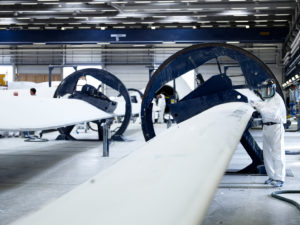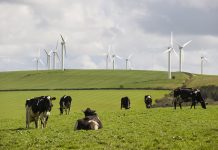Intelligent re-use of hundreds of mammoth end-of-life turbine blades got a boost today, as European wind engineers Vestas spun into recycling.
The Aarhus -headquartered engineer has fabricated over 1,000 blades at its UK base on the Isle of Wight, and recently hinted it may soon confirm up to 2,000 new jobs in the North East. It supplies blades of up to 110 metres to projects worldwide, including SSE Renewables’ 1GW Seagreen park off the Angus coast.

The company announced today a breakthrough in technique for recovering for second use the epoxy materials used to fabricate the giant structures. Vestas leads CETEC – Circular Economy for Thermosets Epoxy Composites – , a circle of chemical engineers, academics and manufacturers.
As much as 90% of material used in turbines can already be recycled, says Vestas. But the blades, composites made of Epoxies and carbon fibre, have presented a problem. Epoxies in essence heat-formed plastics, made up by the reaction of two or more industrial chemicals.
CETEC’s process comes in two stages. Composites are first broken down into fibre and epoxy. A novel chemical recycling process then splits the epoxy further, into base components similar to virgin materials.
The recovered material can then be reintroduced into the manufacturing of new turbine blades, constituting a new circular path for re-use of epoxy resin.
Vestas’ head of advanced materials, Allan Korsgaard Poulsen hailed CETEC’s new technique as an important stepping stone towards the company’s goal of being a zero-carbon turbine producer by 2040.
“As global commitments to net-zero increase, it’s absolutely crucial to ensure the wind industry can scale sustainably…. enabling a future where landfill is no longer required in blade decommissioning”, he said.
Dr Simon Frølich of the Danish Technological Institute, a CETEC member, hailed the technique as a ‘gamechanger’
“The key characteristic of composite materials is their unique combination of low weight and high strength. This is governed by the strong bonding of two different materials – fibre and epoxy. The dilemma is that this strong bond is also the feature that renders these materials difficult to recycle”.
“Enabling disassembly of the composite at end-of-life…will allow us to capture the value represented by each material stream in a new circular value chain” said Frølich.



